Is Ganymede — Not Mars Or Europa — The Best Nearby Place To Look For Alien Life?

The largest moon in our Solar System, often overlooked, is a water-rich world. Does that mean life?
Here on Earth, life took hold very early on in our planet’s history, and has not only survived, but thrived, ever since. While all of the rocky worlds in our Solar System may have been born with similar raw ingredients — including the atoms and precursor molecules that we think are necessary to give rise to life in the first place — not every world possesses the right conditions and properties for life to arise and sustain itself over the ~4.5 billion year history of our Solar System. Earth simply has a combination of characteristics
So where, and how, should we look for life in our cosmic backyard beyond the bounds of Earth? There are numerous good options, including:
- Mars, our colder, smaller sibling that seemed to have a watery past for more than ~1 billion years, and may still house evidence of ancient or even dormant life,
- Venus, which may have been Earth-like before succumbing to a runaway greenhouse effect, and which may possess extant life in its cloud-tops,
- Europa and Enceladus, icy moons of Jupiter and Saturn, with liquid subsurface oceans and geysers that bring that liquid material up through the icy crust and into direct sunlight,
- Titan, Saturn’s giant moon with a thicker atmosphere than Earth and liquid methane on its surface,
- or Pluto and Triton, which are large, icy worlds from the Kuiper belt, both of which have complex weather patterns and also a subsurface liquid ocean.
However, one often-overlooked possibility is the largest moon in our entire Solar System: Jupiter’s third Galilean satellite, Ganymede. With the recent discovery of water vapor in its thin atmosphere, it might just be the overlooked but obvious candidate for life that arose completely independently in the Solar System.
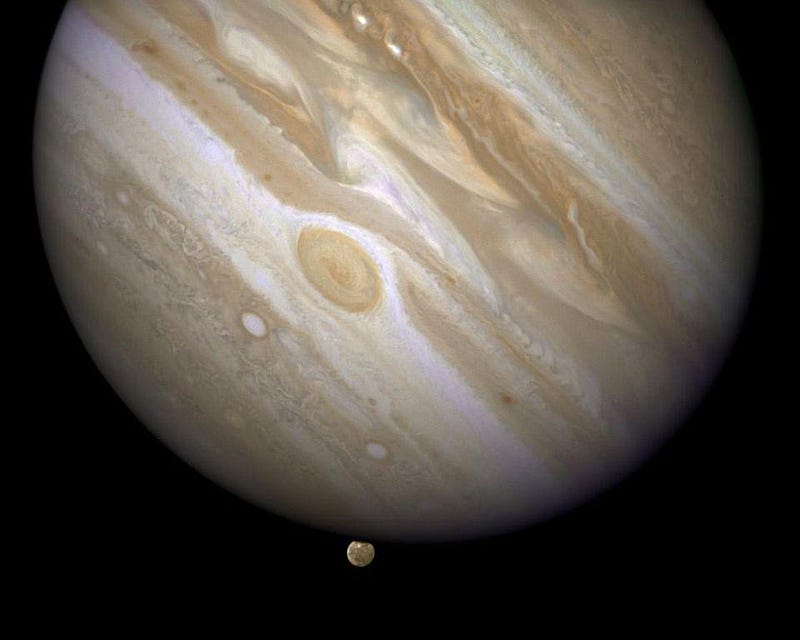
As far as we can tell, there are a few properties that are absolutely essential to life arising on a planet, and another few properties that Earth possesses, but that may or may not be essential, optional, or completely irrelevant when it comes to sustaining and maintaining a living world. The essential ones — at least for the chemical-based life that we know — include:
- the essential elements for life, like carbon, oxygen, nitrogen, hydrogen, and phosphorous,
- configured into essential building blocks like sugars, amino acids, and other vital molecules,
- a source of external energy from the environment with an energy gradient, allowing usable work to be extracted,
- and liquid water, which is absolutely mandatory in all life processes that occur here on Earth.
However, as noted above in the list of candidate worlds in our Solar System where life may exist, either presently or previously, these criteria are likely necessary, but not sufficient, for life to arise and sustain itself. On Earth, we possess a combination of additional factors that seem to be friendly to the kind of life we know of, but that may or may not be requirements.
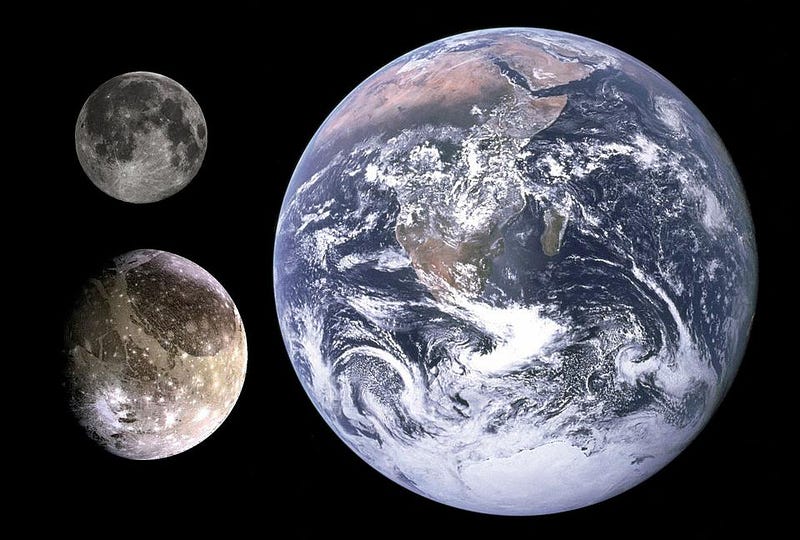
Earth also possesses:
- a substantial magnetic field surrounding it,
- generated by an active, metallic core,
- with a deep, liquid water ocean and land masses of varying topography,
- possessing a substantial atmosphere with a non-negligible pressure at the surface,
- with day/night temperatures that vary substantially, but not by hundreds of degrees,
- with a liquid water/rock interface at the bottom of the oceans,
- powered by external sunlight and internal core heat, creating energy gradients,
- and a relatively large, nearby satellite, capable of creating substantial but not catastrophic differential (tidal) forces on our planet.
Until we have a substantial sample size of worlds where life independently arose, took hold, and sustained itself over cosmological timescales, we have no idea which — if any — of these properties of Earth are important for the success of life on a planet, moon, or other object.
However, looking at this list and at the properties of the other worlds in our Solar System, it’s worth taking a look at Ganymede: the largest moon we know of, and the 8th largest object that goes around the Sun overall.
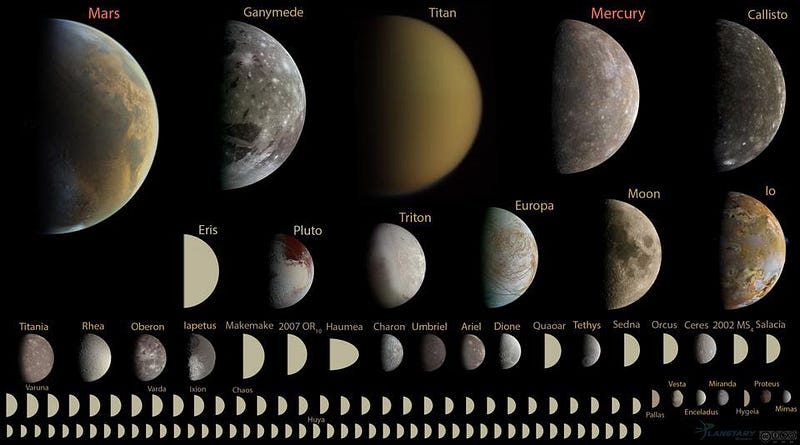
Ganymede is the third of Jupiter’s four large moon, with volcanic Io and ice-rich Europa located interior to it, and the heavily cratered Callisto orbiting beyond it. Ganymede is tidally locked to Jupiter, meaning that its same “face” always points toward the gas giant planet, but since it’s relatively close to Jupiter at an orbital distance of ~1.07 million kilometers, it still manages to complete a full revolution around Jupiter — and hence, a full 360° rotation about its axis — every ~7 days.
A cursory look at Ganymede might lead you to believe it’s a world like the Moon or Mercury: a largely airless world, stripped of its atmosphere and heavily cratered. Its bland, greyish color in photographs makes it appear even more like those two worlds, completely unremarkable and, you might think, completely inhospitable to life. In fact, its only has a very thin atmosphere, and a surface pressure of about ~1 micropascal, provided by a layer of (mostly oxygen) gas. It would take approximately 100 billion Ganymede atmospheres all piled atop one another to achieve the pressures we find here on Earth, and that might be enough to stop you in your tracks right there.
Without an atmosphere, after all, why would we consider Ganymede at all as an interesting world to examine for life?
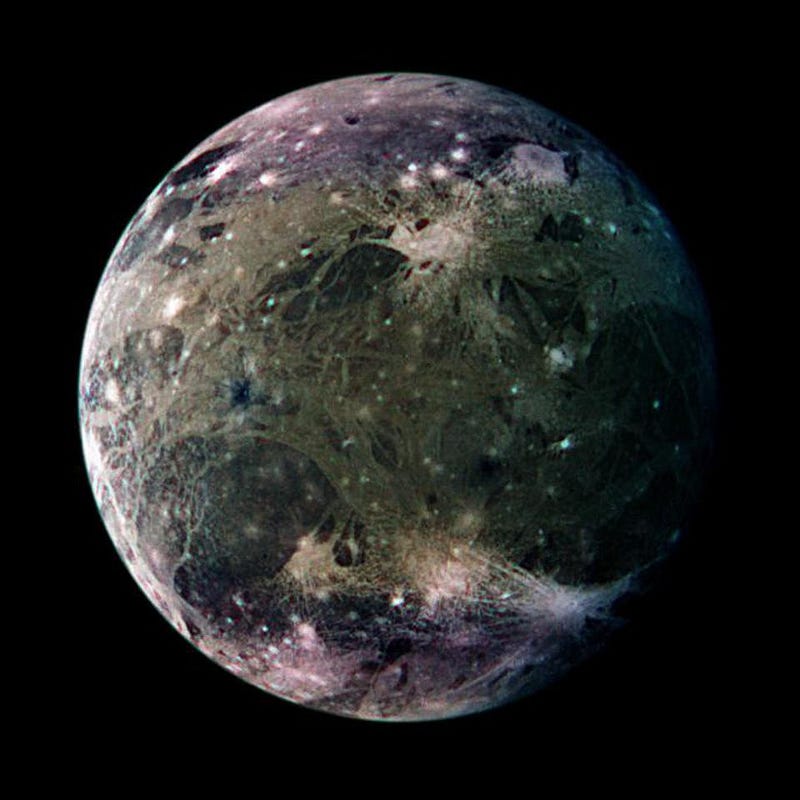
Sure, Ganymede has only a very thin atmosphere, and with an atmosphere that provides so little pressure, it’s impossible to have liquid water on its surface. No liquid water, no life, case closed, right?
How close-minded we’d be if that was where we stopped our line of inquiry. Yes, it’s very very unlikely that we have substantial life processes occurring on the surface of Ganymede. But when we look at the atmosphere in detail — as a new study recently did with archival data from Hubble — we find that Ganymede’s atmosphere has hydrosignatures in it: copious amounts of water vapor.
Finding water vapor and oxygen on Ganymede tell us that the frozen, icy surface of the world actually interacts with the space weather impacting it, and this is despite Jupiter’s strong magnetic field. Molecular oxygen is produced when charged particles impact and erode the ice on the surface, indicating that solar wind particles are getting through. The water vapor, on the other hand, must come about through sublimation: there must be icy regions that get warm enough so that water vapor is not only produced, but is hot enough to thermally escape into the remainder of the atmosphere. Despite Jupiter’s strong, shielding magnetic effects, and Ganymede’s frozen appearance, the puzzle pieces actually put together a tantalizing story.
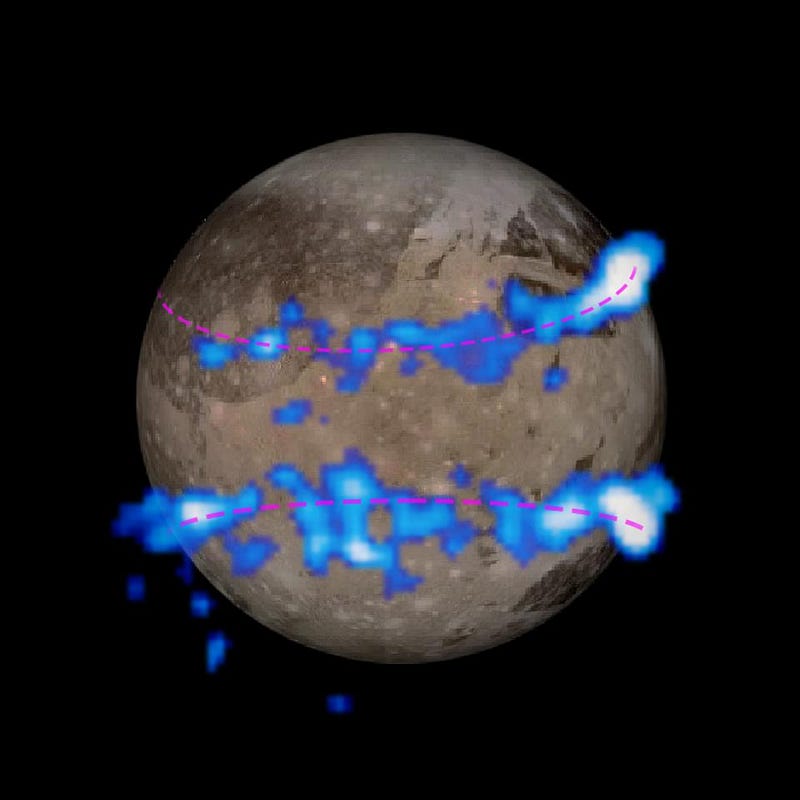
When the first ultraviolet observations of Ganymede were taken — by Hubble’s STIS (spectroscopic) instrument back in 1998 — astronomers got a bit of a surprise: there were bands of auroral activity encircling the moon, evidence that Ganymede isn’t just embedded in Jupiter’s magnetic field, but that it generates a magnetic field of its own. The combination of these two fields, Jupiter’s and Ganymede’s, can lead to particles funneling down onto Ganymede’s surface, given its thin atmosphere, creating the oxygen atmosphere we observe.
But how does Ganymede maintain a magnetic field at all? To understand that, we have to look to Ganymede’s interior, and that’s where the story transforms from, “okay, let’s follow the clues to see where they lead” into “oh wow, maybe we were too quick to write off Ganymede as a potentially inhabited world.”
Yes, Ganymede has an almost negligible atmosphere. And yes, it’s cold: ranging from 70 K at its coldest, on the night side when it’s in Jupiter’s shadow, to 152 K, the maximum daytime temperatures observed by the Galileo spacecraft. And there are large amounts of ice on its surface; approximately 50% or more of the surface is icy, mostly water-ice at that. Other compounds include ammonia, various sulfates, and sulfur dioxide. But things get really, really interesting, when it comes to Ganymede, when we examine what must be going on inside of it.
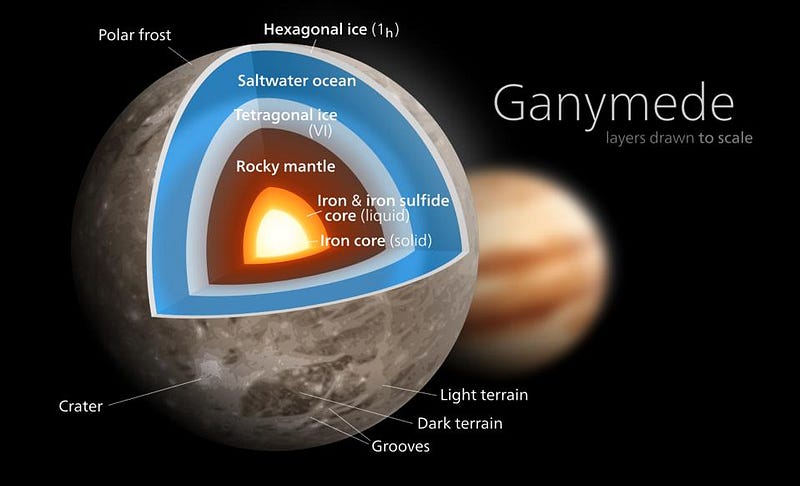
Ganymede’s outer crust is largely made of ices, particularly water-ice that forms a hexagonal crystal structure. Although it’s coated in clays and grooves, with polar frost caps, those minerals are thought to have largely arrived billions of years ago, when the rate of impact craters was very high. The magnetic fields of Ganymede protect the equatorial regions, but allow solar plasmas to strike the poles, resulting in the observed frost at high latitudes. Over the past ~3.5 billion years or so, however, Ganymede’s exterior has remained largely unchanged.
Inside, however, that crystalline ice structure extends downwards for quite a ways: about 160 kilometers. Below that, the temperatures and pressures get high enough that the water no longer remains in its solid phase, but becomes liquid. In other words, there actually is a thick, deep, subsurface ocean underneath the deceptively barren terrain coating the surface of Ganymede, extending all the way down to depths of about 800 km, or nearly a third of the way to its center. Below that, there’s certainly another layer of ice, and possibly multiple layers of ice and liquid in various phases, until you get all the way down to the rocky mantle, which may itself be in contact with a layer of liquid water.
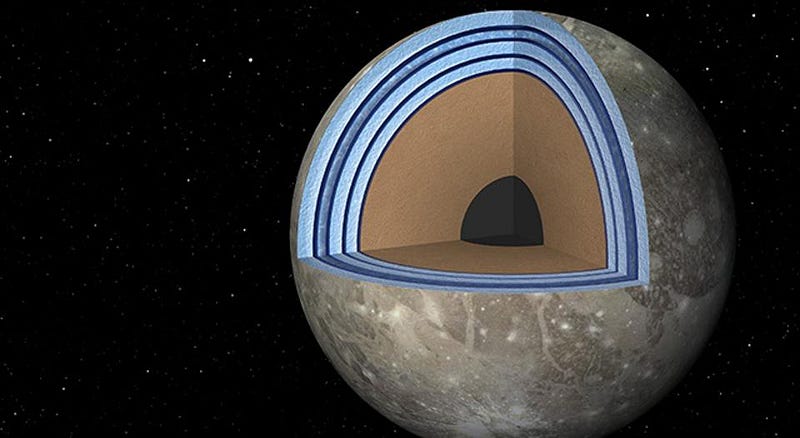
The mantle-water interface at the bottom of a convective ocean would have greatly enhanced thermal temperatures: about 40 K higher than those found at the ice-water boundary lying above it. Further down, beneath the mantle, there’s a liquid metal core surrounding a solid iron-nickel core, which is thought to have a radius of ~500 km, a temperature of around ~1600 K, and a density approximately equal to that of the planet Mercury (about three times the overall density of Ganymede as a whole). Convection in the core is the generally accepted explanation of Ganymede’s observed magnetic field.
With these interior properties, Ganymede all of a sudden transforms from a barren world, akin to Earth’s Moon, to one with perhaps the best chances for life in its ocean deep underground, at the interface between the lowest layer of the liquid oceans and the hot, rocky mantle. Just as we have a unique set of extremophile organisms that thrive around and are uniquely adapted to the environments surrounding the hydrothermal vents here on Earth, it’s eminently possible that something very, very similar is happening ~800 kilometers down, at the ocean/mantle interface, on Ganymede.
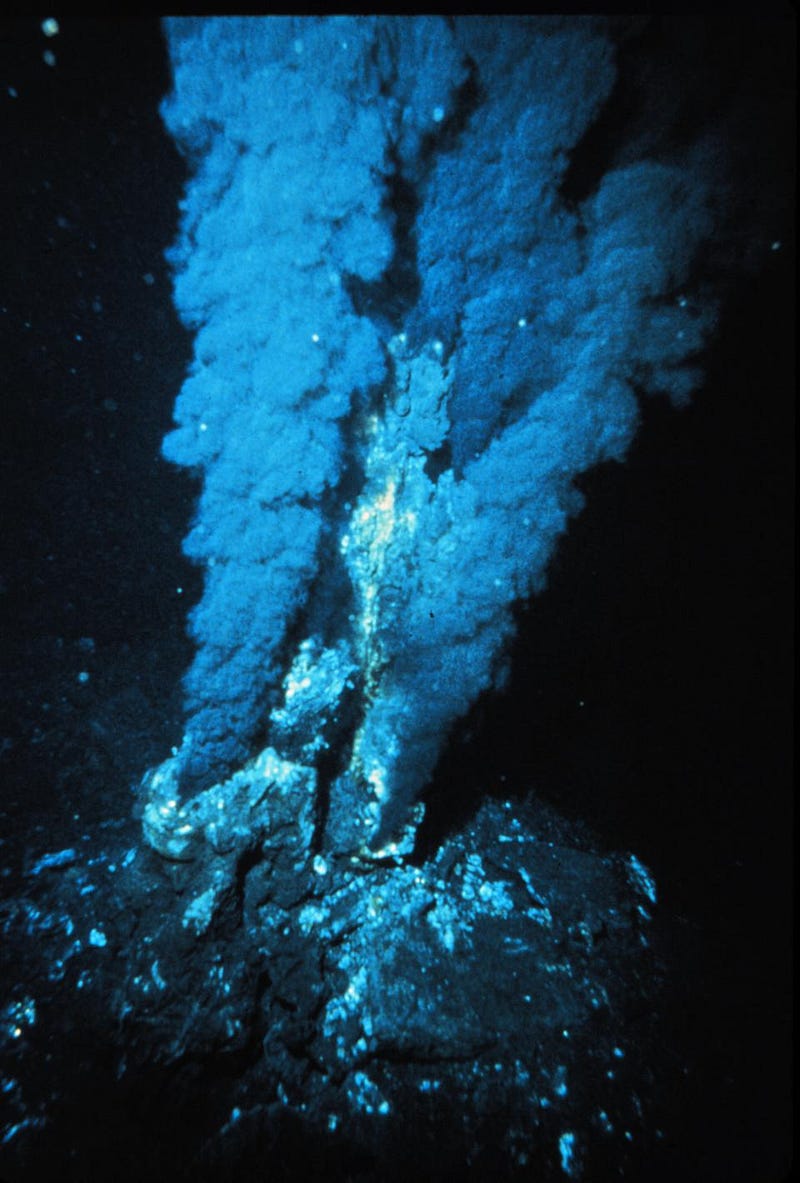
If we run through our checklists from earlier, we find that Ganymede ticks off almost every box. From the essential list, it has:
- the essential elements for life,
- almost certainly possesses those elements configured into biomolecules like amino acids and sugars,
- with an external energy source in the form of heat from the moon’s interior (augmented by the Jovian-induced tides),
- and with copious amounts of liquid water in the environment where life can thrive.
In addition, among the ingredients that Earth possesses but that may or may not be essential or even conducive to life, Ganymede shows:
- that is has a substantial internal and external magnetic field,
- generated by an active, metallic core and being in close proximity to Jupiter,
- with a deep, liquid water subsurface ocean,
- within which the pressure is non-negligible despite having barely any atmosphere at all,
- with day/night temperatures that vary substantially but that should remain within only a few tens of degrees of some mean value,
- with likely a liquid water/rocky mantle interface at the bottom of the ocean,
- powered by internal core heat, creating energy gradients,
- and a massive, nearby host planet, capable of creating substantial but not catastrophic (at its substantial distance from Jupiter) tidal forces on it.
With the exception of having a thick atmosphere and the conditions for surface, rather than subsurface, liquid water, and the fact that life must be driven by internal, rather than external (sunlight) energy gradients, all of these properties are extremely promising as far as the potential for life — at least, as we know it — is concerned.
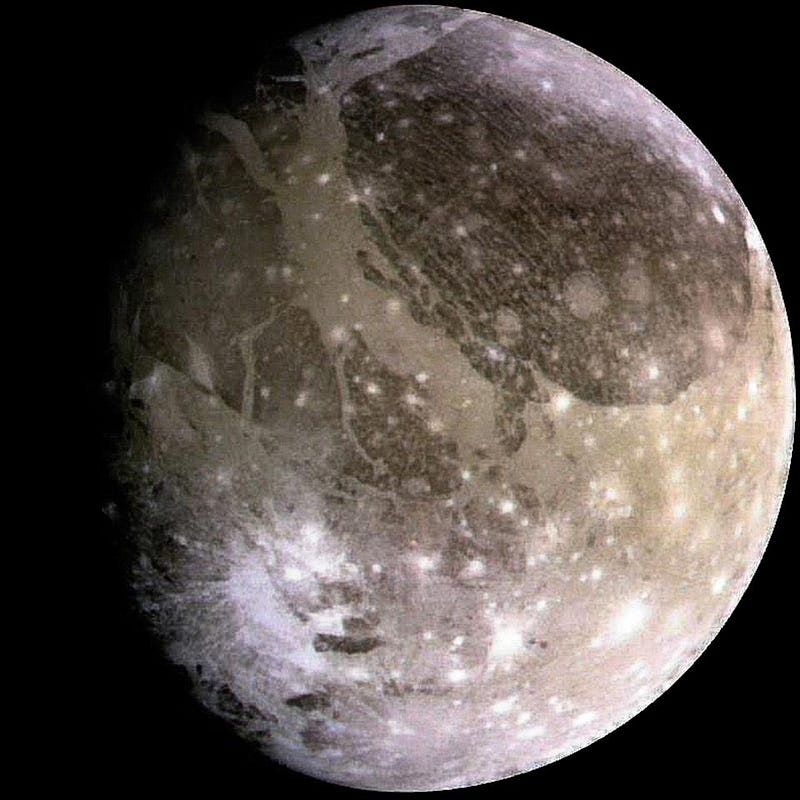
Going all the way back to its birth, Ganymede likely formed very quickly from the circumplanetary disk around Jupiter: possibly on timescales as fast as ~10,000 years. This allowed Ganymede to retain much of the originally accreted heat, leading to differentiation between the core, the mantle, and the icy outer layers. Trapped beneath a thick layer of ice, and affected by a substantial internal magnetic field, Ganymede’s thick, subsurface, liquid water ocean, which should interface directly with the mantle beneath alternating layers of ice and water, might provide a spectacularly fertile environment for the emergence of life, which could then possibly sustain itself indefinitely.
And yet, the Juno probe can only photograph Ganymede from a distance; it will not go into orbit around it. The Europa Clipper mission was selected over a proposed Ganymede mission, leaving the third Galilean satellite out in the cold. Instead, the only current mission planned for Ganymede is the ESA’s Jupiter Icy Moon Explorer (JUICE) mission, which is slated to launch in 2022, to fly past Ganymede in 2029, and to begin orbiting it in 2032. A potential Ganymede lander, Laplace-P, has been proposed by the Russian Space Research Institute, but has gained little traction.
NASA, meanwhile, has no present plans to further explore Ganymede in-depth, which is a shame. Ganymede, as barren as it appears, may actually be one of the best candidates we have for housing life elsewhere in our Solar System. Until the day comes where we put our efforts into actually finding out what’s down there, all we can do is continue to wonder.
Starts With A Bang is written by Ethan Siegel, Ph.D., author of Beyond The Galaxy, and Treknology: The Science of Star Trek from Tricorders to Warp Drive.





